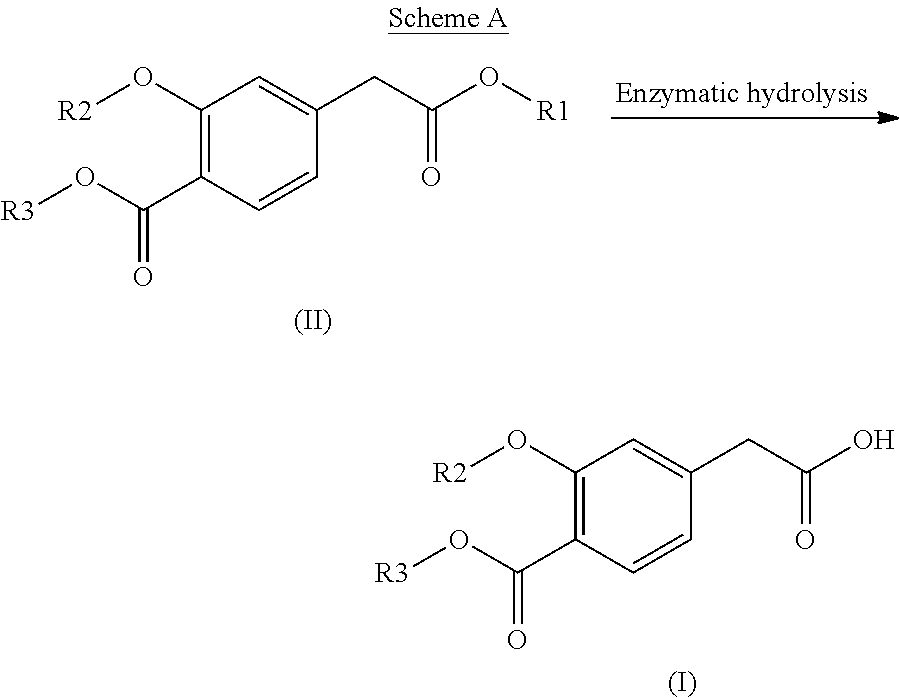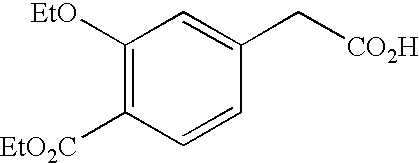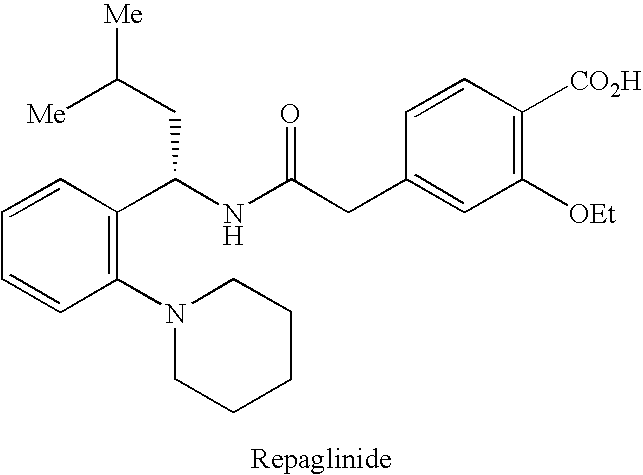Method for the chemo-selective enzymatic hydrolysis if a diester compound for preparing a monoester monoacid compound
a technology of enzymatic hydrolysis and diester compound, which is applied in the field of chemo-selective enzymatic hydrolysis if a diester compound for preparing a monoester monoacid compound, can solve the problems of low mass yield for production of expected products, process for industrial use, and inability to achieve the effect of deteriorating the activity of enzymes
Active Publication Date: 2012-06-12
ZACH SYST SPA +1
View PDF5 Cites 0 Cited by
- Summary
- Abstract
- Description
- Claims
- Application Information
AI Technical Summary
Benefits of technology
This process significantly reduces by-product formation and increases the mass yield of 4-carboxymethyl-2-ethoxybenzoic acid, ethyl ester, making it more industrially compatible and cost-effective for pharmaceutical production.
Problems solved by technology
The limits of this process for an industrial use remain the formation of by-products in appreciable amount, especially the diacid compound that is difficult to remove, the need for several extraction and washing treatments or several recrystallizations to isolate the product and, finally, the low mass yield for production of the expected product.
Moreover, the prior art does not describe any process for preparing a phenylacetic acid compound comprising an ester function on the aromatic nucleus, using a chemoselective enzymatic hydrolysis reaction of a corresponding diester compound.
Method used
the structure of the environmentally friendly knitted fabric provided by the present invention; figure 2 Flow chart of the yarn wrapping machine for environmentally friendly knitted fabrics and storage devices; image 3 Is the parameter map of the yarn covering machine
View moreImage
Smart Image Click on the blue labels to locate them in the text.
Smart ImageViewing Examples
Examples
Experimental program
Comparison scheme
Effect test
example 1 a
50 mg of Diester (Concentration 50 g / l)
[0065]After reaction for 1 hour 50 minutes, a 100% degree of conversion is obtained.
example 1 b
100 mg of Diester (Concentration 100 g / l)
[0066]After reaction for 2 hours 50 minutes, a 100% degree of conversion is obtained.
example 1 c
200 mg of Diester (Concentration 200 g / l)
[0067]After reaction for 3 hours 50 minutes, an 80% degree of conversion is obtained.
the structure of the environmentally friendly knitted fabric provided by the present invention; figure 2 Flow chart of the yarn wrapping machine for environmentally friendly knitted fabrics and storage devices; image 3 Is the parameter map of the yarn covering machine
Login to View More PUM
| Property | Measurement | Unit |
|---|---|---|
| concentration | aaaaa | aaaaa |
| concentration | aaaaa | aaaaa |
| temperature | aaaaa | aaaaa |
Login to View More
Abstract
This disclosure relates to the synthesis of the compound of formula (I) according to Scheme A below:in which R1, R2 and R3, which may be identical or different, represent, individually and independently, an alkyl group, characterized by an enzymatic hydrolysis reaction that involves placing the compound of formula (II) in contact with an enzyme that performs a chemoselective hydrolysis of only one of the two ester functions of the compound of formula (II) to obtain the compound of formula (I).
Description
INTRODUCTION[0001]The present invention relates to a process for synthesizing a 4-carboxymethyl-2-alkyloxybenzoic acid, alkyl ester derivative from the diester derivative.[0002]More specifically, it is a process for preparing 4-carboxymethyl-2-ethoxybenzoic acid, ethyl ester,[0003]which is a key intermediate for the industrial production of the pharmaceutical active principle repaglinide, which is used in the treatment of diabetes.[0004]PRIOR ART[0005]The prior art discloses the article by the author P. Müller et al. published in the review J. Med. Chem., 1998, 41(26), p. 5219, describing a process for synthesizing 4-carboxymethyl-2-ethoxybenzoic acid, ethyl ester, characterized by a selective hydrolysis reaction of the corresponding diester derivative.[0006]This selective hydrolysis reaction is performed in ethanol at a temperature of 25° C. and in the presence of a strong base, for instance an aqueous sodium hydroxide solution.[0007]The limits of this process for an industrial use...
Claims
the structure of the environmentally friendly knitted fabric provided by the present invention; figure 2 Flow chart of the yarn wrapping machine for environmentally friendly knitted fabrics and storage devices; image 3 Is the parameter map of the yarn covering machine
Login to View More Application Information
Patent Timeline
 Login to View More
Login to View More Patent Type & Authority Patents(United States)
IPC IPC(8): C12P7/40
CPCC12P7/62
Inventor BURGOS, ALAINCAILLE, JEAN-CLAUDELORRAINE-GRADLEY, MICHELLE
Owner ZACH SYST SPA
Features
- R&D
- Intellectual Property
- Life Sciences
- Materials
- Tech Scout
Why Patsnap Eureka
- Unparalleled Data Quality
- Higher Quality Content
- 60% Fewer Hallucinations
Social media
Patsnap Eureka Blog
Learn More Browse by: Latest US Patents, China's latest patents, Technical Efficacy Thesaurus, Application Domain, Technology Topic, Popular Technical Reports.
© 2025 PatSnap. All rights reserved.Legal|Privacy policy|Modern Slavery Act Transparency Statement|Sitemap|About US| Contact US: help@patsnap.com



